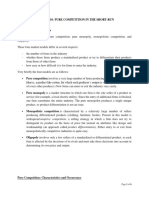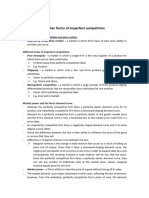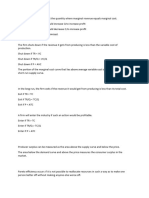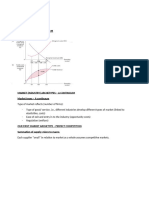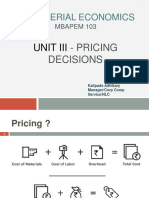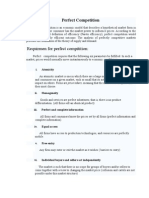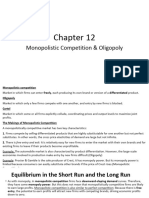CIS Microeconomics Exam Three
CIS Microeconomics Exam Three
Uploaded by
VictoriaCopyright:
Available Formats
CIS Microeconomics Exam Three
CIS Microeconomics Exam Three
Uploaded by
VictoriaOriginal Description:
Copyright
Available Formats
Share this document
Did you find this document useful?
Is this content inappropriate?
Copyright:
Available Formats
CIS Microeconomics Exam Three
CIS Microeconomics Exam Three
Uploaded by
VictoriaCopyright:
Available Formats
CIS Microeconomics Exam Three
Perfect Competition:
Characteristics of Perfect Competition: Many small firms Homogeneous products Freedom of entry and exit Perfect information The Competitive Firm: Firm is a price taker No choice but to accept the price that has been determined by the market Price is set in the market Firm is too small to affect the market Demand Curve: Horizontal demand curve Can sell as much as it wants at the market price. Able to double or triple sales without reducing the price of its product Short Run Equilibrium: Marginal Revenue (MR) = Price (P) Profit maximizing level of output: Marginal Cost = Price MC = MR D = MR = AR = MC at the equilibrium level of output Zero economic profit means that firms are earning the normal, economy wide rate of profit Freedom of entry and exit guarantees this result in the long run under perfect competition in the long run under perfect competition Business needs to be above average cost so the business makes money. If they are below in the long run, the business will fail. If they are too high above AC, competitors will enter the market driving prices down Short-Run Supply Curve: A competitive industry has stable equilibrium at the output level where supply equals demand The competitive industry faces a downward sloping demand curve Shut Down and Break Even Analysis: Rule One: The firm will make a profit if total revenue (TR) > total cost (TC) - Should not plan to shut down in either the short run or long run Rule Two: Even if TR < TC, the firm should continue to operate in the short run as long as TR > TVC - If TR > TVC, the firm can at least pay some of its fixed costs - The firm should close in the long run if TR < TC The competitive firm will produce nothing unless price lies above the minimum point on the AVC curve
Long Run Equilibrium: Firms enter or exit the industry in response to profits or losses Shifts the supply curve and the price until profits are zero Competitive equilibrium P = MC Firms are driven to produce at the minimum point of their average cost curves Output is produced at the lowest possible cost to society Long Run Supply Curve: Supply curve is also the industrys long run average cost curve Driven to the particular supply curve by the entry or exit of firms and by the adjustment of firms already in the industry Efficient Resource Allocation: Efficiency exists when it is not possible to make some people better off without making others worse off Society must somehow choose: - How much of each good to produce The allocation of societys resources among different products depends on consumer preferences (demands) and production costs of the good demanded - What input quantities to use in the production process Inputs are assigned to the firms that can make the most productive (most profitable) use of them - How to distribute the resulting outputs among consumers The price system carries out the distribution process by rationing goods on the basis of preferences and relative incomes Central Planners: Planners cannot carry out the coordination tasks of the economy due to - Lack of necessary data - Computational complications
Monopolies:
Pure Monopoly: An industry in which there is only one supplier of a product for which there are no close substitutes and in which it is very hard or impossible for another firm to coexist Only one firm may exist in the industry No close substitutes for the monopolists products may exist There must be come reason why entry and survival of potential competitors is extremely unlikely *Doesnt have a supply curve because monopolies are price makers (can set the price at anything they want)
Characteristics of a Monopoly: Opposite of competitive firms
- Sole producer (industry = firm) - Unique product with no close substitutes - Price-makers (but cant ignore the demand curve) - Demand curve is downward sloping - To increase sales, monopolies must reduce prices If a firm is truly a monopoly, market entry is blocked
Government Involvement in a Monopoly: The government gives exclusive rights (patents, copy right laws) No involvement price maker Barriers to Entry: Legal restrictions Patents Control of a scarce resource or input Deliberately erected entry barriers Large sunk costs Technical superiority Economies of scale Compare a Monopoly with Perfect Competition: Compared to perfect competition, a monopoly: - May enjoy a long run profit - Restricts its outputs to raise its selling price (long run and short run) - Leads to inefficient resource allocation (MC < MU) Short Run: - Monopolist and perfect competition can earn economic profit but will just shut down unless AR covers AVC Long Run: - Monopolists, unlike perfect competition, can continue to earn economic profit as long as the entry of new firms is blocked
Price Discrimination: Charge different prices to different groups of customers (or charge the same price in markets where costs vary) Allows a monopolist to maximize profits Sets marginal revenue (not price) equal in each market Assumes equal cost conditions in each market Examples: School lunches, student/senior discounts, property tax Not always desirable: - May be necessary for a firm to survive - Where there are significant economies of scale, price discrimination may actually lead to lower prices
Monopolistic Competition:
Monopolistic Competition: A market in which products are heterogeneous but which is otherwise the same as a market that is perfectly competitive. A market is said to operate under the conditions of monopolistic competition if it satisfies these requirements: - Numerous participants - Freedom of exit and entry - Perfect information - Heterogeneous products Each sellers product differs at least somewhat from every others Collusion: When a group of firms try to control price or quantity Illegal Cartel: A group of sellers of a product who have joined together to control its production, sale, and price in the hope of obtaining the advantages of a monopoly OUTPUT!
Oligopolistic Markets
A market dominated by a few sellers, at least several of which are large enough relative to the total market to be able to influence the market price Big Businesses Oligopolies can sell similar products (steel plate from different steel manufacturers) or different products (Hondas, BMW, Toyota). Some also contain many smaller firms (Different pop manufacturers) but they are still oligopolies because a few large firms carry out the bulk of the industrys business and smaller firms must follow the larger firms. Price Wars: Each competing firm is determined to sell at a price that is lower than the prices of its rivals, usually regardless of whether that price covers the pertinent cost. Typically in such a price war, Firm A cuts its price below Firm Bs; then FB retaliates by undercutting A. Prisoner Dilemma & Game Theory: Economists most widely used approach to analyze oligopoly behavior. Work under the assumption that their rivals are extremely ingenious strategic decision makers. Each oligopoly acts as a competing player in a strategic game. Uses two concepts: Strategy and the payoff matrix The payoff matrix reports the profits that each firm can expect to earn, given its own pricing choice and that of its rival The Maximin Strategy and the Prisoners Dilemma: - Maximin Criterion: Requires you to select the strategy that yields the maximum payoff on the assumption that your opponent does as much damage to you as they can. - To best protect a company, game theory suggests that the firm should base their strategy based on the minimum payoff
You might also like
- Chapter 35 - Different Market StructuresDocument52 pagesChapter 35 - Different Market StructuresPhuong DaoNo ratings yet
- Price and Output Determination Under Different Market StructuresDocument19 pagesPrice and Output Determination Under Different Market StructuresAnkush Bhoria43% (7)
- Porter's Five Forces: Understand competitive forces and stay ahead of the competitionFrom EverandPorter's Five Forces: Understand competitive forces and stay ahead of the competitionRating: 4 out of 5 stars4/5 (10)
- IB Economics Notes - Macroeconomic EquilibriumDocument13 pagesIB Economics Notes - Macroeconomic EquilibriumPablo Torrecilla100% (1)
- Notes 9 11 EcoDocument10 pagesNotes 9 11 Ecogaggia1984_288982357No ratings yet
- An Overview of Monopolistic CompetitionDocument9 pagesAn Overview of Monopolistic CompetitionsaifNo ratings yet
- Chap 8 - Managing in Competitive, Monopolistic, and Monopolistically Competitive MarketsDocument48 pagesChap 8 - Managing in Competitive, Monopolistic, and Monopolistically Competitive MarketsjeankerlensNo ratings yet
- Market StructureDocument10 pagesMarket Structuretanatswagendere1No ratings yet
- Presetation On Perfectly Competittive Market Vs Monopoly: Rafi Ahmed (11100100030)Document16 pagesPresetation On Perfectly Competittive Market Vs Monopoly: Rafi Ahmed (11100100030)Rafi AhmêdNo ratings yet
- BECC-101 INTRODUCTORY MICROECONOMICS_31503564Document24 pagesBECC-101 INTRODUCTORY MICROECONOMICS_31503564Theja LakshmiNo ratings yet
- Chapter 5 - Market StructureDocument19 pagesChapter 5 - Market Structurejosephyoseph97No ratings yet
- Market StructureDocument26 pagesMarket StructureimittesafNo ratings yet
- Managerial Economics CHAPTER 9 UpdatedDocument58 pagesManagerial Economics CHAPTER 9 UpdatedYve LuelleNo ratings yet
- Lecture - 01. PURE COMPETITION: Handout - 1Document11 pagesLecture - 01. PURE COMPETITION: Handout - 1sofia100% (1)
- Karina Market Structure SummaryDocument4 pagesKarina Market Structure SummaryKarina Permata SariNo ratings yet
- T5. CompetitionDocument4 pagesT5. CompetitionNothing ThereNo ratings yet
- Economics Exam Notes - MonopolyDocument5 pagesEconomics Exam Notes - MonopolyDistingNo ratings yet
- Market 9624Document7 pagesMarket 9624pialchowdhurymahmudNo ratings yet
- Market Structure A LevelDocument30 pagesMarket Structure A Leveloluwaseun4adeoluNo ratings yet
- Market Structures HandoutDocument10 pagesMarket Structures HandoutSuzanne HolmesNo ratings yet
- Econ This IsDocument11 pagesEcon This Isbeasteast80No ratings yet
- Market Structure ManeconDocument59 pagesMarket Structure Maneconhazelle.magmanlac52466No ratings yet
- 102 - UNIT 4Document43 pages102 - UNIT 4gaurav.singh.somensiNo ratings yet
- BBA BE S1 U4 (1)Document11 pagesBBA BE S1 U4 (1)Tanish LalwaniNo ratings yet
- Market Structure - Internal Rivalry: Pricing in Perfect CompetitionDocument10 pagesMarket Structure - Internal Rivalry: Pricing in Perfect CompetitionlavamgmcaNo ratings yet
- Pure Competition in Short Run - NotesDocument6 pagesPure Competition in Short Run - Notessouhad.abouzakiNo ratings yet
- Economic Analysis Ch.7.2023Document24 pagesEconomic Analysis Ch.7.2023Amgad ElshamyNo ratings yet
- Reviewer MicroeconomicsDocument10 pagesReviewer MicroeconomicsDaisyrei CatapangNo ratings yet
- Econ NotesDocument8 pagesEcon Noteshussein.imam.17No ratings yet
- Summary CH2Document6 pagesSummary CH2Antonio Vera GonzálezNo ratings yet
- Pure CompetitionDocument9 pagesPure Competitioncindycanlas_07No ratings yet
- 8 - Managing in Competitive, Monopolistic, and Monopolistically Competitive MarketsDocument6 pages8 - Managing in Competitive, Monopolistic, and Monopolistically Competitive MarketsMikkoNo ratings yet
- Chapter 7 The Theory of The Firm II Market StructureDocument27 pagesChapter 7 The Theory of The Firm II Market StructureHieptaNo ratings yet
- Perfect CompetitionDocument21 pagesPerfect Competitionkingsleymay08No ratings yet
- Micro Notes Chapter 10Document10 pagesMicro Notes Chapter 10D HoNo ratings yet
- unit-4 (Economics)Document29 pagesunit-4 (Economics)bhupeshshrestha111No ratings yet
- PGDM - Market StructuresDocument13 pagesPGDM - Market StructuresRavi ChoubeyNo ratings yet
- Chapter Two: Demand and SupplyDocument71 pagesChapter Two: Demand and Supplykasech mogesNo ratings yet
- Monopoly MergedDocument58 pagesMonopoly Mergedsaundarya.m2003No ratings yet
- Microeconomics Final Study Guide 2Document14 pagesMicroeconomics Final Study Guide 2gdare802No ratings yet
- 5Document37 pages5Belayneh AsmareNo ratings yet
- 1.5.monopolistic CompetitionDocument13 pages1.5.monopolistic CompetitionManhin Bryan KoNo ratings yet
- PRICINGDocument8 pagesPRICINGkunalagrey.milsNo ratings yet
- Market Structures Perfect CompetitionDocument4 pagesMarket Structures Perfect CompetitionJovie TandocNo ratings yet
- Chap9-Monopoly-10 15 2021Document17 pagesChap9-Monopoly-10 15 2021shaireneavanez9No ratings yet
- Monopoly Equilibrium UploadedDocument10 pagesMonopoly Equilibrium Uploadedasal661No ratings yet
- Monopolistic CompetitionDocument5 pagesMonopolistic CompetitionSyed BabrakNo ratings yet
- EC 131 Market StructuresDocument15 pagesEC 131 Market StructuresPlaxedesNo ratings yet
- Economics NotesDocument10 pagesEconomics NotesAaron DowlingNo ratings yet
- Lecture 1 NotesDocument5 pagesLecture 1 NotesanelvelianisNo ratings yet
- Eco 2nd Sem Unit 1Document4 pagesEco 2nd Sem Unit 1Mr BeastNo ratings yet
- Lesson 6 - Perfect Competition - 2024Document20 pagesLesson 6 - Perfect Competition - 2024iced. teaNo ratings yet
- Chapter 8 F2013 Lecture SlidesDocument10 pagesChapter 8 F2013 Lecture Slideslpinedo12No ratings yet
- Managerial Economics: Unit IiiDocument44 pagesManagerial Economics: Unit IiiJeff RamosNo ratings yet
- Chapter 6 - GROUP 1 APPLIED ECONOMISDocument18 pagesChapter 6 - GROUP 1 APPLIED ECONOMISkassandra.abrocio99No ratings yet
- Requirmen For Perfect CompititionDocument4 pagesRequirmen For Perfect CompititionVijayNo ratings yet
- Test 3 Study Guide Chapter 12 - Production and Cost Analysis I Production FirmDocument8 pagesTest 3 Study Guide Chapter 12 - Production and Cost Analysis I Production FirmJosephNo ratings yet
- Profit Maximization and Competitive SupplyDocument4 pagesProfit Maximization and Competitive SupplyRodney Meg Fitz Balagtas100% (2)
- Chapter 12 FunalDocument9 pagesChapter 12 FunalQamar VirkNo ratings yet
- Managerial Economics: Market StructureDocument24 pagesManagerial Economics: Market StructureviewpawanNo ratings yet
- Monopolistic Competition, Oligopoly, and Pure MonopolyDocument5 pagesMonopolistic Competition, Oligopoly, and Pure MonopolyImran SiddNo ratings yet
- Microecon Chapter Six NotesDocument2 pagesMicroecon Chapter Six NotesVictoriaNo ratings yet
- Microecon Chapter Three NotesDocument3 pagesMicroecon Chapter Three NotesVictoriaNo ratings yet
- CIS Microeconomics Exam One ReviewDocument5 pagesCIS Microeconomics Exam One ReviewVictoriaNo ratings yet
- CIS Microeconomics Exam One ReviewDocument5 pagesCIS Microeconomics Exam One ReviewVictoriaNo ratings yet
- World History 16.1-16.3 NotesDocument2 pagesWorld History 16.1-16.3 NotesVictoriaNo ratings yet
- World History Conflagration NotesDocument2 pagesWorld History Conflagration NotesVictoriaNo ratings yet
- World History Chapter 24 NotesDocument3 pagesWorld History Chapter 24 NotesVictoriaNo ratings yet
- World History Semester Two Self-TestDocument11 pagesWorld History Semester Two Self-TestVictoriaNo ratings yet
- World History Middle Ages (Unit 4) Study GuideDocument3 pagesWorld History Middle Ages (Unit 4) Study GuideVictoriaNo ratings yet
- CIS Psych Exam Two Study GuideDocument9 pagesCIS Psych Exam Two Study GuideVictoriaNo ratings yet
- Macroeconomics 11e Arnold Ch9 Classical Macroeconomics Attempt 1Document5 pagesMacroeconomics 11e Arnold Ch9 Classical Macroeconomics Attempt 1PatNo ratings yet
- Principles of Microeconomics HL Ahuja DownloadDocument3 pagesPrinciples of Microeconomics HL Ahuja Downloaddeo305233No ratings yet
- ECN 306 - Marginalists SchoolDocument16 pagesECN 306 - Marginalists SchoolAbbieNo ratings yet
- Foreign Direct Investment and Manufacturing Growth: The Malaysian ExperienceDocument8 pagesForeign Direct Investment and Manufacturing Growth: The Malaysian ExperienceKhizer SikanderNo ratings yet
- CH 11Document28 pagesCH 11Mike Cheshire0% (1)
- ............... May - Oct 20 U3 QPDocument28 pages............... May - Oct 20 U3 QPYuvipro gidwaniNo ratings yet
- DocxDocument50 pagesDocxMohammed AljabriNo ratings yet
- Solved Draw A Figure Similar To The Left Panel of FigureDocument1 pageSolved Draw A Figure Similar To The Left Panel of FigureM Bilal SaleemNo ratings yet
- Ch-9 - Ist Sem 23-24Document120 pagesCh-9 - Ist Sem 23-24Hrishikesh KasatNo ratings yet
- Semester IIDocument16 pagesSemester IIPatel PritNo ratings yet
- Multiple Choice Questions 1 Where Sras and Ad Currently IntersDocument2 pagesMultiple Choice Questions 1 Where Sras and Ad Currently Interstrilocksp SinghNo ratings yet
- Cost Armen Alchian - Text and Questionnaire Prof. Rodrigo Peñaloza UnBDocument28 pagesCost Armen Alchian - Text and Questionnaire Prof. Rodrigo Peñaloza UnBGuilherme MartheNo ratings yet
- Chapter 9Document21 pagesChapter 9kumikooomakiNo ratings yet
- AS-AD ModelDocument59 pagesAS-AD Modelanchal11102003No ratings yet
- Chapter Six: Pricing Decisions AND Cost ManagementDocument39 pagesChapter Six: Pricing Decisions AND Cost ManagementEbsa AbdiNo ratings yet
- SM 12 Economics English 201617Document196 pagesSM 12 Economics English 201617GAMENo ratings yet
- NMIMS Microeconomics - BookDocument312 pagesNMIMS Microeconomics - BookParichay PalNo ratings yet
- Chapter 3 Continuation-NotesDocument3 pagesChapter 3 Continuation-NotesRaxelle MalubagNo ratings yet
- MAS CPAR - EconomicsDocument7 pagesMAS CPAR - EconomicsJulie Ann LeynesNo ratings yet
- Chapter-1 125626Document11 pagesChapter-1 125626Jelna CeladaNo ratings yet
- Chapter 8 Managing in CompetitiveDocument28 pagesChapter 8 Managing in CompetitiveAngela WaganNo ratings yet
- Instant download Essential Foundations of Economics Seventh Edition Bade pdf all chapterDocument77 pagesInstant download Essential Foundations of Economics Seventh Edition Bade pdf all chapteratikavitkop7100% (1)
- Kertas Kerja Modul Pelatihan 2024 TambahanDocument207 pagesKertas Kerja Modul Pelatihan 2024 TambahanSalsabila AufaNo ratings yet
- Viljoen RP 1868880958 Section6Document34 pagesViljoen RP 1868880958 Section6rangotomandoNo ratings yet
- İmtahan Suallari-MacroeconomicsDocument2 pagesİmtahan Suallari-MacroeconomicsElşən OrucovNo ratings yet
- 4a - Decision Making and Marginal CostingDocument23 pages4a - Decision Making and Marginal CostingCindy ClollyNo ratings yet
- The Role of Electronic-Trading Platform and Dividends Policies in Banks' Liquidity - SpringerLinkDocument12 pagesThe Role of Electronic-Trading Platform and Dividends Policies in Banks' Liquidity - SpringerLinkmohammadNo ratings yet
- Concept of Cost in Long Run and EnvelopeDocument21 pagesConcept of Cost in Long Run and Envelopeneha pu100% (1)
- Final Project in EconomicsDocument164 pagesFinal Project in EconomicsGenesis MenesesNo ratings yet

























